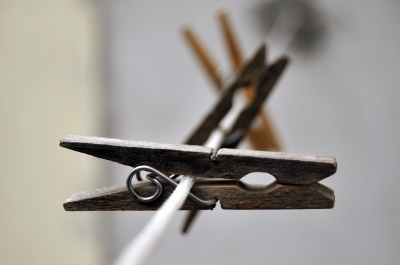One of these days it’s going to be a fan dipole…
 For most beginning ham operators, a half-wave dipole is the starting point. A simple wire dipole is normally center-fed. The dipole was invented by Heinrich Hertz around 1886.
For most beginning ham operators, a half-wave dipole is the starting point. A simple wire dipole is normally center-fed. The dipole was invented by Heinrich Hertz around 1886.
The dipole is one of the most popular antennas and one of the most practical. It’s easy to design and easy to install. In fact, the set of rabbit ears we used for the TV is an example of a dipole antenna.
Any ham radio enthusiast will know that to formulate the magic number for the dipole, one would divide 468 by the frequency (468/F). This would give us the length of the half-wave dipole. To get the length of each leg, we divide the number in half.
For example, say we want to cut a dipole for the 40 meter band, we would want to find a frequency that we usually talk on. Let’s use 7.150 MHz as the frequency. Dividing 468 by 7.15 we get 65.4 feet. Each leg is 32.7 feet in length, which is called a quarter-wave. Vertical antennas are based on the quarter wave.
I ordered a center piece to attach both legs to, which is called a center insulator. The center insulator can be purchased anywhere that amateur radio gear is sold. My center insulator was around 14 dollars. It has two opposite ends to attach the wire to using bolts. Simply wrap the wire around the bolts and tighten with a wrench. (I’ve learned to make my own, but buying the insulator is still the best method.)
The store-bought center insulator worked magnificently. This obviously gives you something to attach the wire legs to, as well as the coax.
I used to tighten the wire as tight as I could get it between two trees, but over time I’ve discovered this will cause strong winds to snap the wire, so now I let the dipole jingle freely. It’s a better way.
In this case, some sag is good!
I also purchased what is called dog bones for the ends of the wire. These are small plastic pieces that have holes on each end, for a place to attach the wire and rope. After years of experience, I’ve learned to make them myself. Plastic PVC pipe works just fine and will last for years. I drill holes to slip the copper wire through.
After climbing that old ladder a zillion times, I finally figured out that I like the inverted vee dipole the best. The flat top style is okay (it used to be my favorite), but the vee tends to pull in a better signal, and it definitely cuts down on the electrical line noise.
Another lesson that I’ve learned is that the line noise is too great near a power pole. My strong advice is to stay away from them.
I use no balun or 450 ladder line; just the wire fed with coax. I use the thin gray coaxial cable and it still works after all these years. The name is Astatic and I highly recommend this brand.
Workman is another option.
The 40 meter dipole was a big winner for me. Initially, I ran mine from north to south. The first weekend I worked over 12 stations in Europe on the wire. Boy, was I a happy camper.
This was several years ago. I now use the inverted vee version, so any angle will do just fine because the apex is less than what is required. Under these circumstances, the direction will be multi-directional.
Update October 22, 2015: I have tried this antenna for several years and I’ve changed my mind on a few things that I’d like to mention. It’s best to find resonance on any antenna, but I’ve also found that there are sweet spots that work for different other ham bands. I usually give myself an extra foot on each leg nowadays.
For the 40 meter band, I like to cut each leg about 34 feet. This is in the same range, it’s just another foot longer than the 33-foot length. I now prefer the inverted vee style instead of the flat top.
The 40 meter full-wave loop is another option. It has slightly different characteristics than the dipole, and generally is better on the long distance DX. I use them both for different applications. In many instances, nothing beats a good old inverted vee dipole.
One of these days and I may decide to go for the fan dipole. One of these days…
Image Credit:
Image: Carlos Porto / FreeDigitalPhotos.net


Link exchange is nothing else but it is just placing the other
person’s website link on your page at appropriate place and other person will also do similar in support of you.
If some one wants to be updated with latest technologies therefore he must be go to see this web site and be up to date daily.
Thank you so much for giving everyone remarkably pleasant chance
to read in detail from this web site. It is always so sweet and also stuffed with a good time for me and
my office friends to visit your web site the
equivalent of thrice in one week to read the latest guidance you will have.
Of course, I am also always impressed with all the
attractive tactics you give. Some 3 ideas in this article are in reality the most beneficial I’ve ever had.